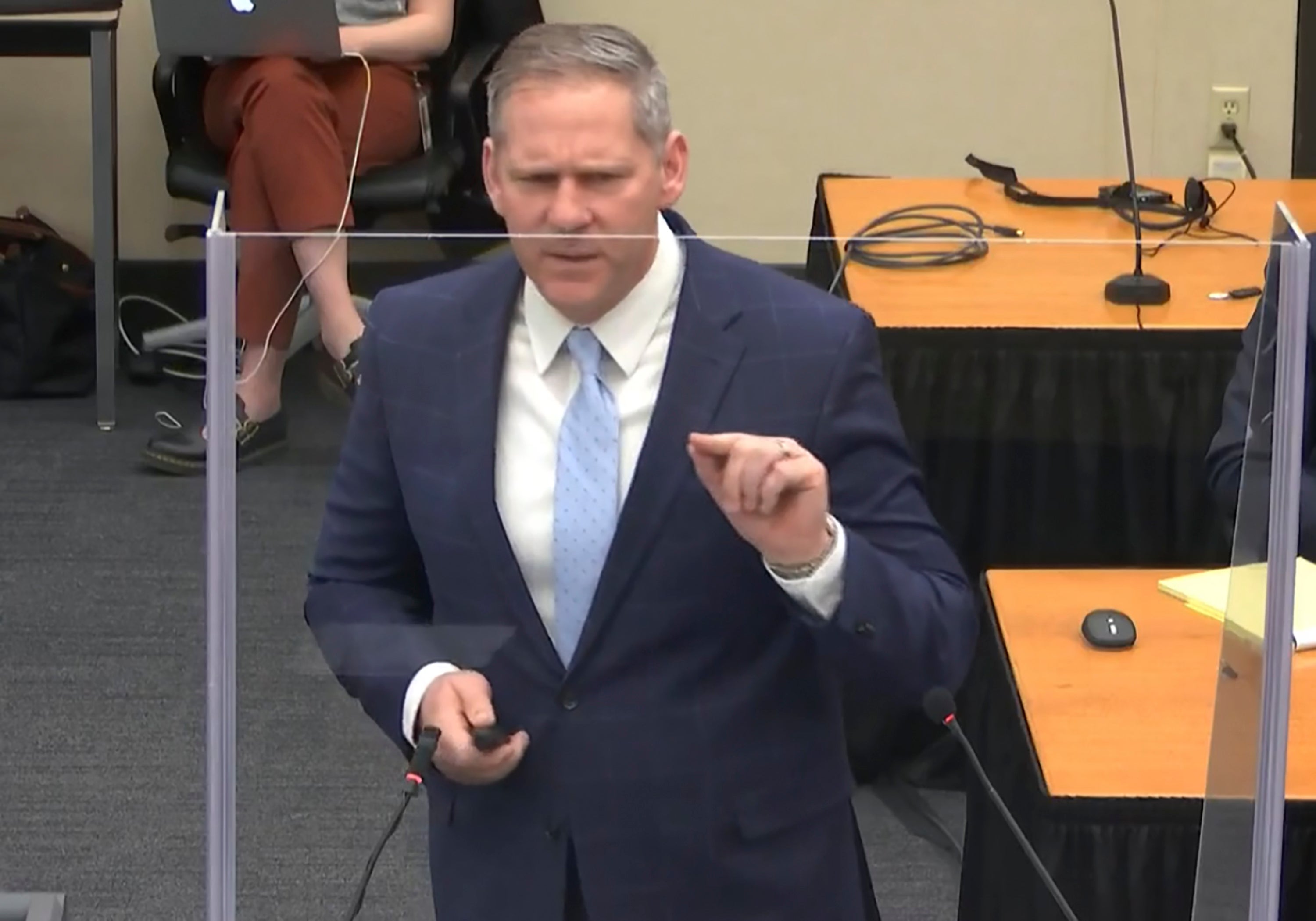Why did ‘excited delirium’ come up at Derek Chauvin trial?
The attorney for the former Minneapolis police officer accused of murder and manslaughter in George Floyd’s death outlined the disputed concept of excited delirium at trial

Your support helps us to tell the story
From reproductive rights to climate change to Big Tech, The Independent is on the ground when the story is developing. Whether it's investigating the financials of Elon Musk's pro-Trump PAC or producing our latest documentary, 'The A Word', which shines a light on the American women fighting for reproductive rights, we know how important it is to parse out the facts from the messaging.
At such a critical moment in US history, we need reporters on the ground. Your donation allows us to keep sending journalists to speak to both sides of the story.
The Independent is trusted by Americans across the entire political spectrum. And unlike many other quality news outlets, we choose not to lock Americans out of our reporting and analysis with paywalls. We believe quality journalism should be available to everyone, paid for by those who can afford it.
Your support makes all the difference.The attorney for the formerMinneapolis police officer accused of murder and manslaughter in George Floyd ’s death outlined the disputed concept of excited delirium at trial in an effort to show that the force Derek Chauvin used was objectively reasonable given Floyd’s resistance.
Floyd, a 46-year-old Black man, was arrested outside a neighborhood market on May 25, accused of trying to pass a counterfeit $20 bill. A panicky-sounding Floyd struggled and said he was claustrophobic as police tried to shove him into a squad car. After three officers pinned Floyd to the ground, Thomas Lane, a rookie officer at the scene, can be heard on body camera video asking whether he might be experiencing excited delirium.
Meanwhile, Chauvin pressed his knee to Floyd’s neck for about 9 1/2 minutes, even as Floyd struggled, said he couldn’t breathe and eventually became limp.
HOW HAS EXCITED DELIRIUM COME UP?
Defense attorney Eric Nelson last week recalled Nicole Mackenzie, a Minneapolis police officer who trains other officers in medical care and who had already testified for the prosecution.
Mackenzie told the jury that new officers are taught how to recognize signs of excited delirium. Suspects may be incoherent, she said, exhibit extraordinary strength, sweat or suffer from abnormal body temperature, or seem like they suddenly snapped. They’re taught that cardiovascular disease, drug abuse or mental illness can trigger excited delirium, she said.
But she told the jury that she would defer to an emergency room doctor in diagnosing the condition.
In closings Monday, prosecutor Steve Schleicher said Floyd had not exhibited any of those recognized signs.
“There’s no superhuman strength,” Schleicher told the jury. “There are no super humans, impervious to pain. Nonsense. You heard him. You saw him. He was not impervious to pain. It’s nonsense.”
WHY DOES IT MATTER?
A key question at Chauvin’s trial has been whether he used reasonable force in pinning Floyd to the pavement for 9 minutes, 29 seconds while Floyd was handcuffed and lying on his stomach, complaining that he couldn’t breathe. Minneapolis Police Department officials testified that he did not — that Floyd was under control so force should have quickly ended.
Nelson emphasized that Floyd was bigger than Chauvin, suggested that suspects can present a danger even when handcuffed, and that handcuffs can fail. He also suggested that Chauvin was rightly concerned about angry onlookers. A defense use-of-force expert, Barry Brodd, a former Santa Rosa, California, police officer, testified that Chauvin was justified in pinning Floyd to the ground because of his frantic resistance.
WHAT DOES SCIENCE SAY ABOUT EXCITED DELIRIUM?
Some medical examiners in recent decades have attributed in-custody deaths to excited delirium, often in cases where the person had become extremely agitated after taking drugs, having a mental health episode or other health problem. But there is no universally accepted definition of it and researchers have said it’s not well understood.
The American Psychiatric Association’s diagnostic handbook doesn’t list the condition and one study last year concluded it is mostly cited as a cause only when the person who died had been restrained.
Early in the trial, Dr. Bill Smock — an expert in forensic medicine who works as a police surgeon for the Louisville Metro Police Department in Kentucky and as a professor of emergency medicine at the University of Louisville — testified that he believes excited delirium is real. But he said Floyd met none of the 10 criteria developed by the American College of Emergency Physicians. A minimum of six signs are required for the diagnosis, he said.
A medical examiner in New York concluded that Daniel Prude was in a state of excited delirium in 2020 when police in Rochester put a hood over his head and pressed his naked body against the pavement. Prude, a Black man, lost consciousness and died. State Attorney GeneralLetitia James recommended that officers be trained to recognize the symptoms of excited delirium.
Elijah McClain — a Black man put in a stranglehold by officers in Aurora, Colorado, in 2019 — was injected with ketamine after first responders said he was experiencing excited delirium. He wound up on life support and later died.
___
Find AP’s full coverage of the death of George Floyd at: https://apnews.com/hub/death-of-george-floyd